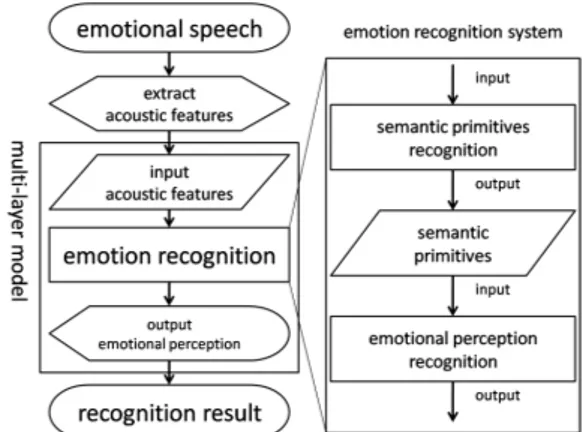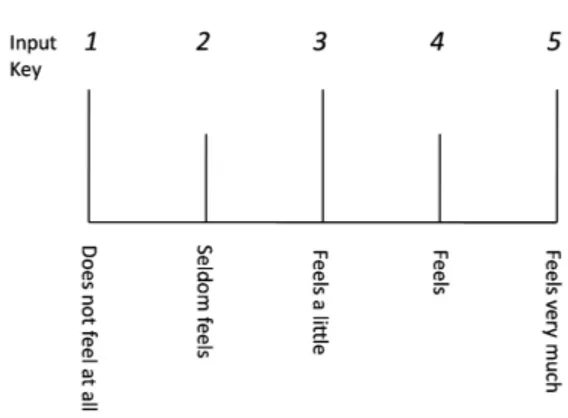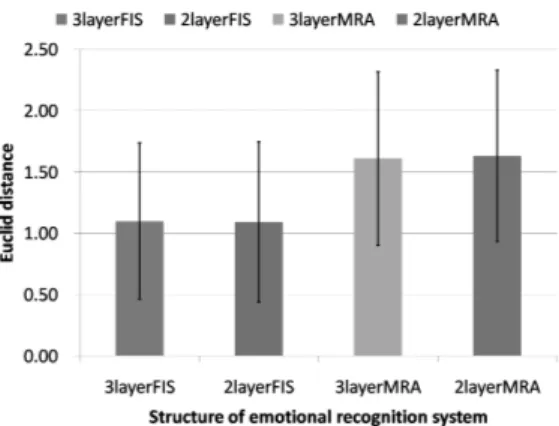JAIST Repository
https://dspace.jaist.ac.jp/Title
An emotional speech recognition system based on
multi-layer emotional speech perception model
Author(s)
Aoki, Yuusuke; Huang, Chun-Fang; Akagi, Masato
Citation
2009 International Workshop on Nonlinear Circuits
and Signal Processing (NCSP'09): 133-136
Issue Date
2009-03-01
Type
Conference Paper
Text version
publisher
URL
http://hdl.handle.net/10119/9965
Rights
This material is posted here with permission of
the Research Institute of Signal Processing
Japan. Yuusuke Aoki, Chun-Fang Huang, and Masato
Akagi, 2009 International Workshop on Nonlinear
Circuits and Signal Processing (NCSP'09), 2009,
pp.133-136.
An emotional speech recognition system based on multi-layer emotional speech perception model
Yuusuke Aoki, Chun-Fang Huang, and Masato Akagi
School of Information Science
Japan Advanced Institute of Science and Technology 1–1 Asahidai, Nomi, Ishikawa, 923–1292 Japan Phone/FAX:+81–761–51–1699 (Ex. 1391)/+81–761–51–1149
Email:{y-aoki, chuang, akagi}@jaist.ac.jp
Abstract
We can communicate using speech from which various infor-mation can be perceived. Emotion is an especial element that does not depend on the content of the utterance and is use-ful in communications that reflects the speaker’s intention. Moreover, multiple emotions are usually perceived from one speech utterance, and speech contains various emotions to the various intensity. However, traditional emotion recognition systems directly map the emotional speech to the categories of emotion using acoustic features of speech signals. It can be hardly said that these method imitate the human percep-tion mechanism. To imitate human perceppercep-tion mechanism, in this study, we attempt to construct an emotional speech recognition system based on the multi-layer perception model for emotional speech proposed by Huang and Akagi [1]. We evaluate other emotion recognition systems in terms of Euclid distance and correlation between system outputs and ideal intensity. The results indicated that the multi-layer system shows an internal structure clearly and has the recognition ac-curacy equivalent to that of the two-layer system. In a sense of imitating the perception mechanism of humans, the con-structed system provides a more effective emotion recogni-tion system compared with the convenrecogni-tional methods.
1. Introduction
We can communicate using speech from which various information can be perceived. Information included in the speech is roughly divided linguistic information that shows the content that speaker is intended to convey and non-linguistic information that includes individual, emotion and dialect etc. of the utterance. Emotion is an especial element that does not depend on the content of the utterance and is useful in communications that reflects the speaker’s intention. Moreover, speech contains various emotions to the various degrees.
In the researches on emotional speech, acoustic features are directly mapped into the emotional category. However, in hu-man’s sensory process, emotional perception is performed by perceiving the vague semantic primitives based on acoustic features and by combining these features.
In this study, we attempt to construct an emotional speech recognition system which imitates the human perception mechanism by adding semantic primitives between acoustic features and emotional perception. This constructed system is also able to recognize the multiple emotions in speech due to the use of semantic primitives.
2. Multi-layer emotional speech perception model [1]
We introduce the elements and connections used in this model. Figure1 shows the emotion perception multi-layer model. This model was constructed for the vague human perception modeling. This model employs three-layer struc-ture for expressing perception process from acoustic feastruc-tures to emotion. In particular, this model has semantic primitive layer between acoustic feature layer and expressive speech layer. Furthermore, emotion perception is modeled by com-bination of semantic primitives. This model can judge the change in emotion layer as semantic primitives change.
2.1. Composition of this model
In this section, we explain the elements which constitute each layer. Importance of acoustic features and semantic primitives elements were established in modeling process.
2.1.1. Elements of this model
A total of 16 acoustic features were used: four involved F0–mean value of rising slope (RS), highest pitch (HP), av-erage pitch (AP) and rising slope of the first accentual phrase (RS1st); four involved power envelope–mean value of power 2009 International Workshop on Nonlinear Circuits and Signal Processing NCSP'09, Waikiki, Hawaii, March 1-3, 2009
Figure 1: Conceptual diagram of multi-layered perceptual for emotional speech.
range in accentual phrase (PRAP), power range (PWR), rising slope of the first accentual phrase (PRS1st), the ratio between the average power in high frequency portion (over 3 kHz) and the average power (RHT); five involved the power spectrum– first formant frequency (F1), second formant frequency (F2), third formant frequency (F3), spectral tilt (SPTL), spectral balance (SB); and three involved duration total length (TL), consonant length (CL), ratio between consonant length and vowel length (RCV).
Semantic primitives layer uses 17 kinds (bright, dark, high, low, strong, weak, calm, unstable, well-modulated, monotonous, heavy, clear, noisy, quiet, sharp, fast, and slow) as elements.
Emotional perception layer uses five kinds (Neutral, Joy, Cold-Anger, Sadness, and Hot-Anger) as elements. Neutral is used as a standard of all emotion. Joy, Sadness and Anger are most fundamental emotion. However, we often perceive the difference between Hot-Anger and Cold-Anger. Therefore, Hot-Anger and Cold-Anger are differently processed.
2.1.2. Connections in this model
This section introduces how to connect the elements in the model.
Human perceive emotion from semantic primitives by vague judgement. Therefore, we should take vague judge-ment into consideration when connecting emotion perception and semantic primitives. Fuzzy Inference System (FIS) is able to formulate the mapping from input to output and clas-sify pattern by the rule of IF-THEN form [3]. FIS which in-cludes both symbol processing and numeric processing repre-sents vague experimental knowledge of human according to the IF-THEN form. FIS connected elements between layers
Figure 2: The flow-chart of the emotional recognition system.
based on vague judgement of human.
To connect semantic primitives and acoustic features, we should investigate which acoustic features change when hu-man perceives the changing sehu-mantic primitives.
3. Emotional speech recognition system
In this study, we construct emotion recognition system based on multi-layer emotional speech perception model [1]. In our recognition system, system output does not decide one emotion category but uses emotion intensity level. Therefore, it is expected that the constructed recognition system can rec-ognize multiple emotion intensity level as humans do.
We connect the layers to satisfy input-output relation re-quirements at each recognition part. In the proposing recog-nition system, we connect all relations between layers by Adaptive Neuro-Fuzzy Inference System unlike in the case of Huang and Akagi [1]. We implement semantic primitives recognition part which output semantic primitives intensity by using the input of acoustic features extracted from speech data, and emotional perception part which output emotion in-tensity by using the input of semantic primitives value with multiple FIS [3]. The recognition system can output multiple emotion intensity after revealing perception process of human using FIS.
The system we constructed is shown in Figure2.
3.1. Extraction of elements
3.1.1. Speech data
179 utterances of the Fujitsu emotion speech database were used in this research. There are 20 kinds of speech sentences, and there are 9 kinds of emotions in each sentence. How-ever, the data of 1 utterance is missed. These utterances are intended 5 kinds of emotion.
Figure 3: Evaluation measure of the listening test.
3.1.2. Acoustic features
Acoustic features are required as the input of emotion recognition system. In this research, acoustic features which originate from F0, power envelope and power spectrum are extracted by the high quality speech analysis-synthesis sys-tem STRAIGHT [2]. Moreover, acoustic features which are related to duration are extracted by segmentation. About acoustic features, the ratios of changed values from Neutral are used. The average of values with the Neutral label is cal-culated and the value of the ratio on the basis of this is used. 3.1.3. Semantic primitives and Expressive speech
We need values of subjective judgement from speech data as output of semantic primitives recognition part, input and output of emotion recognition part. To extract semantic primitives and expressive speech, we carry out listening test. About each utterance, we extract intensity of semantic prim-itives and expressive speech by listening test of subjective judgement.
In the listening experiments, intensity of each impression about 17 kinds of semantic primitives and 5 kinds of emotion perception for 179 kinds of utterances used in this research was evaluated by five stages, as shown in Figure3.
In the experiments, one impression was evaluated in one session. There were 23 sessions in total. The values of se-mantic primitives and emotional perception were used as the input and output of the recognition system. In this research, 9 native Japanese graduate students participated in the exper-iments.
3.2. Construction of recognition system
In this section, we introduce construction of semantic prim-itive recognition and emotional perception recognition, as shown in Figure2. We should also consider connection of
Table 1: Four systems configurations.
model multi-layer two-layer
using FIS multi-layerFIS two-layerFIS using MRA multi-layerMRA two-layerMRA
weak relation for emotion perception. In this research, the recognition system is implemented using all the elements of this model. We use FIS in all connections.
FIS has the structure of multiple inputs and one output. Therefore, the recognition system needs 17 kinds of seman-tic primitives FIS and 5 kinds of expressive speech FIS. Each initial FIS are constructed based on input and output. The initial FIS changes to the one with the ideal input-output re-lation by learning. The initial FIS of 17 kinds for seman-tic primitives and 5 kinds of emotional perception were con-structed using 80% utterances of FUJITSU emotional speech database. Moreover, it is necessary to examine the suitable iteration numbers of FIS so that generation of the recognition error by over-training may not take place in neuro-adaptation study. That number is convergent point of check error of FIS proposed by Lee and Narayanan [4].
In this research, in order to decide the suitable itera-tion numbers the convergent point of check error of FIS in closed data was investigated based on the research of Lee and Narayanan. From the results, we decided that suitable iter-ation number of semantic primitives FIS is 120 and that of semantic primitives FIS is 150.
The emotion recognition system was mounted by combin-ing 22 FIS that we constructed.
4. Experimental evaluation
For comparison, we adopt a two-layer model for investi-gating the effectiveness of the multi-layer model and a Multi Regression Analysis (MRA) for investigating the effective-ness of multiple FIS. By combination of these models, we prepared 4 kinds of systems like Table1. We compared the recognition accuracy of these systems.
The two-layer recognition system using FIS is based on the system proposed by Moriyama and Ozawa [5]. Acous-tic features and emotional perception were made the same as emotional perception multi-layer model.
As the basis of discussion of recognition result of each recognition system, there are two important points. Namely, whether system output has value close to ideal and whether resembles the interaction of intensity of each emotion by lis-tening tests. It was checked whether the output of a system would be absolutely close to an evaluation value according to the Euclid distance. It was checked whether it was being able
Figure 4: Evaluation results by Euclid distance between sys-tem outputs and ideal intensity.
Figure 5: Evaluation results by correlation between system outputs and ideal intensity.
to recognize the relative relation of emotion by correlation. The results of Euclid distance are shown in Figure4and the results of correlation are shown in Figure5. Euclid distance which is small is better, and correlation which is close to 1 is better.
4.1. Evaluation of FIS
The compared results for vagueness of human perception, i.e., for FIS and MRA, indicate that the recognition systems with FIS are more useful than those with MRA, because the Euclid distance of FIS was suppressed by 0.68 of MRA, and correlation of FIS was improved 0.12 from MRA.
4.2. Evaluation of the multi-layer model
The comparison results for imitation of human perception, i.e., for multi-layer and two-layer, indicate that significant dif-ferences were not observed between the recognition systems
based on the multi-layer model and those based on the two-layer model even at the significance level of 0.01. These re-sults indicate that the multi-layer system shows an internal structure clearly, and has the recognition accuracy equivalent to the two-layer system.
5. Conclusion
In this study, we constructed an emotion recognition sys-tem based on the multi-layer model proposed by Huang and Akagi [1], in order to imitate human perception mechanism. The results using FIS are better than those using MRA. Fur-thermore, the two-layer and multi-layer models can recognize emotion at the almost same accuracy. Since a multi-layer model can also judge the change of semantic primitives, it is better than the two-layer model in imitation of human per-ception. In a sense of imitating the perception mechanism of human, the constructed system provides a more effective emotion recognition system compared with the conventional methods.
6. Acknowledgement
This study was supported by SCOPE (071705001) of Min-istry of Internal Affairs and Communications (MIC), Japan.
References
[1] C. F. Huang and M. Akagi, “A three-layerd model for ex-pressive speech perception,” Speech Commun., 50, 810– 828, 2008.
[2] H. kawahara, I. Masuda-Katsuse, and A. Cheveigne, “Resturcturing Speech Representations Using a Pitch Adaptive Time-Frequency Smoothing and an Instantaneous-Frequency-Based F0 Extraction,” Speech Commun., 27, 187–207, 1999.
[3] J. S. R. Jang, C. T. Sun, and E. Mizutani, “Neuro-Fuzzy and Soft Computing,” Prentice Hall, 1996.
[4] C. Lee and S. Narayanan, “Emotion recognition us-ing a data-driven fuzzy inference system.” in Proc. Eu-rospeech, pp. 157–160, 2003.
[5] T. Moriyama and S. Ozawa, “Measurement of Human Vocal Emotion Using Fuzzy Control,” System and Com-puters in Japan, Vol. 32, No. 4, pp. 59–68, 2001.


